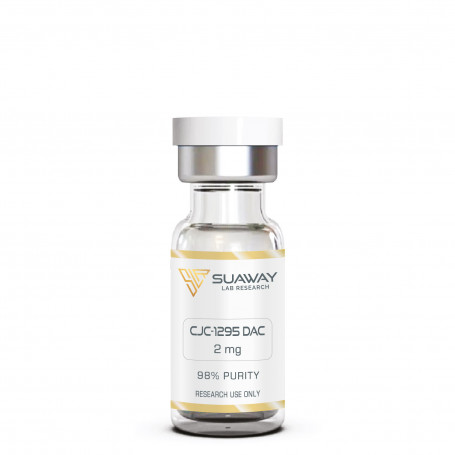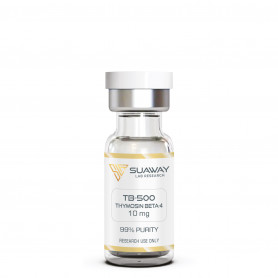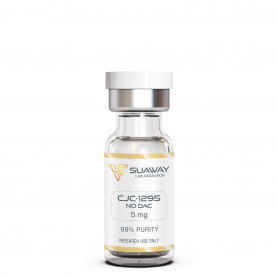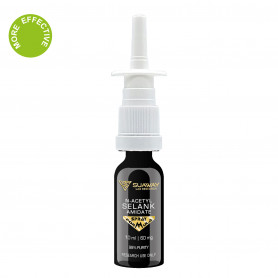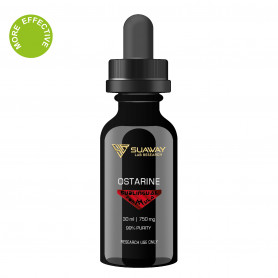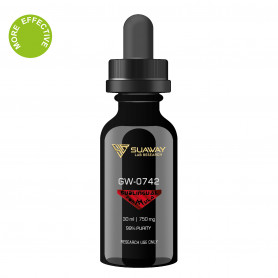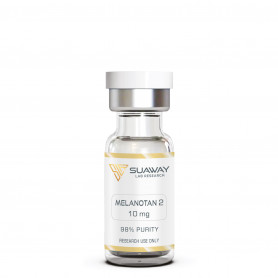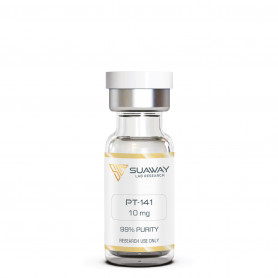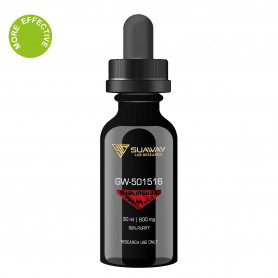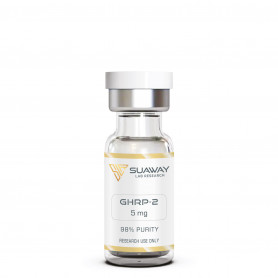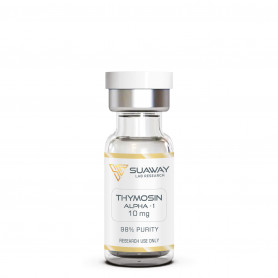CJC-1295 DAC - 2mg
Growth hormone and insulin-like growth factor 1 are both produced in greater amounts in the blood when CJC-1295, a synthetic equivalent of growth hormone releasing hormone (GHRH), is taken (IGF-1). The plasma half-life of CJC-1295 may be extended thanks to an additional molecule known as DAC.
It has been shown to have the effects that are listed below:
- Increases lean body mass and protein synthesis
- Reduced body fat.
Beschreibung
STRUCTURE
Sequence: Tyr-D-Ala-Asp-Ala-Ile-Phe-Thr-Gln-Ser-Tyr-Arg-Lys-Val-Leu-Ala-Gln-Leu-Ser-Ala-Arg-Lys-Leu-Leu-Gln-Asp-Ile-Leu-Ser-Arg-Lys(Malimide-beta-Ala)-NH2
Molecular Formula: C165H269N47O46
Molecular Weight: 3648.4 g/mol
CAS: 863288-34-0
Peptide purity: greater than 98%
Other details: No TFA Salt, No Mannitol
Storage: Lyophilized peptide must be stored at -20 ° C and peptide solution at + 4 ° C
CJC-1295 DAC has low oral and excellent subcutaneous bioavailability.
DESCRITPION
Because CJC-1295 is a modified form of the first 29 amino acids found in GHRH, it has a molecular structure with other GHRH mimics, such as Sermorelin. The modified GRF (1-29) peptide is the one to which it is most comparable, however the two peptides are not the same. Because of the similarities between these peptides and the fact that CJC-1295 was first developed with an additional chemical molecule that was referred to as the drug affinity complex (DAC), there is a significant lot of misunderstanding that emerges between the two.
DAC is incorporated into the molecule, with the assistance of a lysine linker, in order to provide the peptide with protection while it is travelling through the circulatory system. DAC contributes to ensuring that the half-life of CJC-1295 is much longer than that of other compounds with a comparable structure, such as GRF, by facilitating the binding of peptides to albumin, the most prevalent protein found in blood (1-29).
Both CJC-1295 DAC and Modified GRF (1-29) are excellent growth hormone-releasing hormones, and their actions in the human body are almost comparable. Both of these hormones may be found here. In spite of this, there exist variances between these two peptides in terms of their respective half-lives. The action half-life of modified GRF 1-20 is only thirty minutes, whereas the CJC-1295 DAC can last for up to eight days. Many researchers have found that the action half-life of modified GRF 1-29, which is also shorter, is much more natural because it produces a shorter pulse of human growth hormone.
In order to prevent any misunderstandings, CJC-1295 that is packaged with DAC is referred to as CJC-1295-DAC, whilst CJC-1295 that does not include DAC is simply referred to as CJC-1295 or CJC-1295-no DAC.
In its role as a releasing analogue (GHRH) growth hormone, CJC-1295 DAC has shown very promising outcomes. It has not only been shown to be capable of increasing the quantity of IGF-I and growth hormone that is secreted, but it also has the capacity to do so in considerable quantities.
According to studies, a single dosage of CJC-1295 increases the amount of growth hormone (GH) in mice by 2-10 times. The benefits of the treatment typically persist for about eight days, and peak GH levels are attained roughly two hours after injection.
Recent research investigations indicate that CJC-1295 promotes IGF-1 and HGH production without boosting prolactin levels. These findings come from the research. As a direct consequence of this, there is a rise in the rate of protein synthesis as well as a considerable reduction in fat loss.
The middle of the 2000s saw the beginning of CJC-1295's first round of clinical research trials being conducted. The peptide was designed to alleviate fat deposits that are common in individuals with Aids. The fact that increased doses of exogenous HGH cause a reduction in body fat served as the foundation for the idea. The majority of the people who participated in this clinical investigation found that it was beneficial.
Studies have shown that the use of GHRP in conjunction with CJC 1295 DAC results in a considerable rise in the release of GH and IGF-1 without an accompanying increase in the levels of prolactin. These findings are consistent with one another. Ipamorelin and GHRP-2 are two peptides that are excellent examples of GHRHs.
It has been established that CJC-1295 may sustain the physiologic effects of growth hormone on hyperplasia, hypertrophy, bone density, blood sugar, fat metabolism, protein synthesis, and the function of myocardium (heart cell).
Research conducted in the early 1990s shows that the ovulation-stimulating properties of CJC-1295 and other GRF analogues may be helpful in treating infertile female patients. Ovulation is known to be controlled both directly and indirectly by GH release and cycling, as well as being reliant on the hormone IGF-1, which has been known to researchers for quite some time. The findings of studies conducted on animal models of superovulation have contributed to the validation of these hypotheses by demonstrating that the levels of both GH and IGF-1 considerably increase close to the time of ovulation. In addition, the results of these investigations suggest that the exogenous injection of GH secretagogues, such as CJC-1295, is sufficient to induce normal ovulation. It has been hypothesised that CJC-1295 and its analogues would be able to assist control sperm production, which would make them effective in the treatment of male infertility.
REFERENCES
M. Alba et al., "Once-daily administration of CJC-1295, a long-acting growth hormone-releasing hormone (GHRH) analog, normalizes growth in the GHRH knockout mouse" [PubMed]
M. Alba et al., "Once-daily administration of CJC-1295, a long-acting growth hormone-releasing hormone (GHRH) analog, normalizes growth in the GHRH knockout mouse" [American Journal of Physiology-Endocrinology and Metabolism]
S.L. Teichman et al., "Prolonged stimulation of growth hormone (GH) and insulin-like growth factor I secretion by CJC-1295, a long-acting analog of GH-releasing hormone, in healthy adults" [PubMed]
L. Sackmann-Sala et al., "Activation of the GH/IGF-1 axis by CJC-1295, a long-acting GHRH analog, results in serum protein profile changes in normal adult subjects" [PubMed]
A. Volpe et al., "Clinical use of growth hormone-releasing factor for induction of superovulation" [PubMed]
M. Ionescu et al., "Pulsatile secretion of growth hormone (GH) persists during continuous stimulation by CJC-1295, a long-acting GH-releasing hormone analog" [PubMed]
DISCLAIMER
This product is intendend for lab research and development use only. These studies are performed outside of the body. This product is not medicines or drugs and has not been approved by the FDA or EMA to prevent, treat or cure any medical condition, ailment or disease. Bodily introduction of any kind into humans or animals is strictly forbidden by law. This product should only be handled by licensed, qualified professionals.
All product information provided on this website is for informational and educational purposes only.

